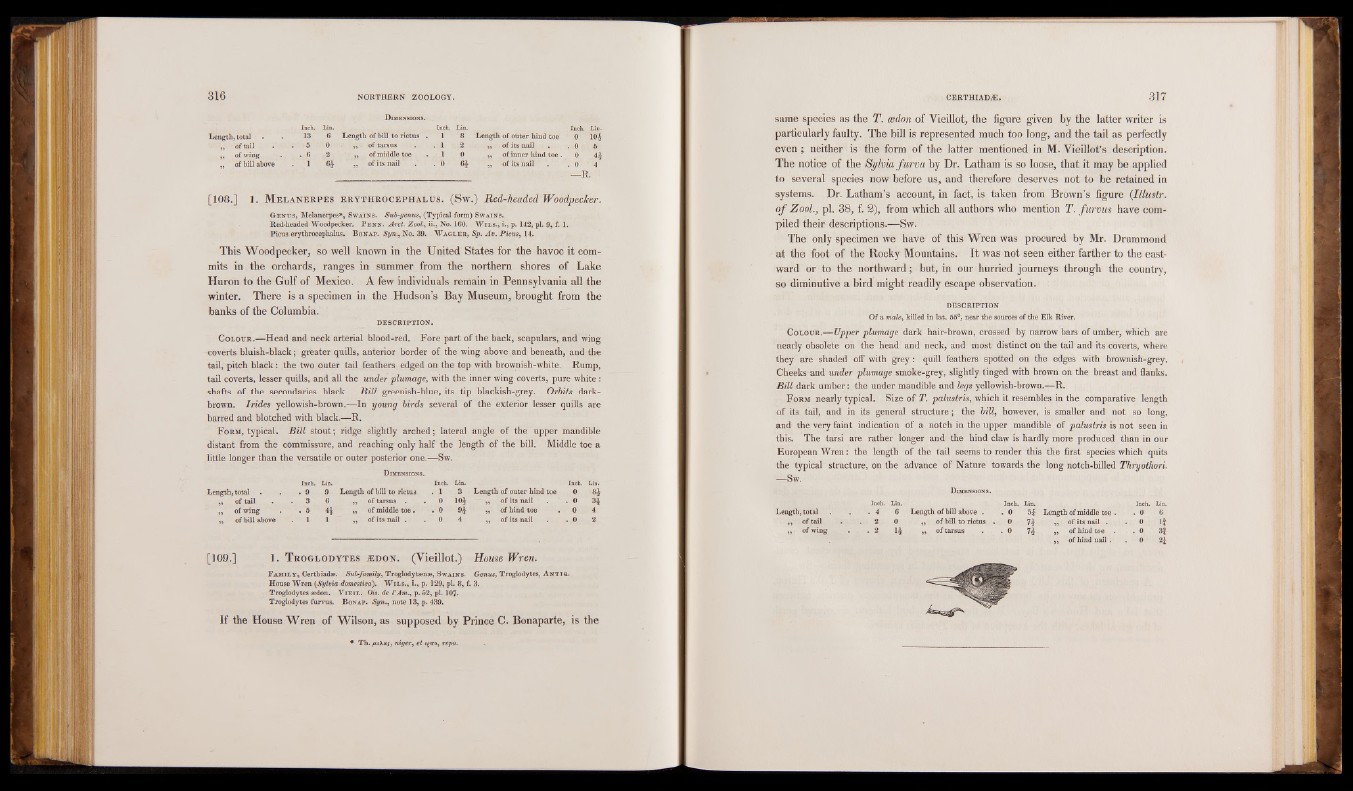
Dimensions.
Inch. Lin. Inch. Lin. Inch. Lin.
Length, total . • 13 6 Length of bill to rictus . 1 8 Length of outer hind toe 0 10^
of tail • . 5 0 . ,, • of tarsus . 1 2 . . „ of its nail . . 0 6
,, of wing . 6 2 • ,, of middle toe 1 0 ,, of inner hind toe . 0
,, of bill above 1 6£ ,, of its nail . 0 6& „ of its nail . 0 4 —R.
[108.] 1. M e l a n e r p e s e r y t h r o c e p h a l u s . (Sw .) Red-headed Woodpecker.
Ge n u s , Melanerpes*, Sw ain s. Sub-genus, (Typical form) Sw ain s.
Red-headed Woodpecker. P e n n . Arct. Zool., ii., No. 160. W il s ., i., p. 142, pi. 9, f. 1.
Picus erythrocephalus. B o nap. Syn., No. 39. W a g l e r , Sp. Av. Picus, 14.
This Woodpecker, so well known in the United States for the havoc it commits
in the orchards, ranges in summer from the northern shores of Lake
Huron to the Gulf of Mexico. A few individuals remain in Pennsylvania all the
winter. There is a specimen in the Hudson’s Bay Museum, brought from the
banks of the Columbia. DESCRIPTION.
C o l o u r .—Head and neck arterial blood-red. Fore part of the back, scapulars, and wing
coverts bluish-black; greater quills, anterior border of the wing above and beneath, and the
tail, pitch black: the two outer tail feathers edged on the top with brownish-white. Rump,
tail coverts, lesser quills, and all the under plumage, with the inner wing coverts, pure white:
shafts of the secondaries black. Bill greenish-blue, its tip blackish-grey. Orbits dark-
brown. Irides veUowish-brownJg lln young birds several of the exterior lesser quills are
barred and blotched with black.—R.
F orm, typical. Bill stout; ridge slightly arched; lateral angle of the upper mandible
distant from the commissure, and reaching only half the length of the bill. Middle toe a
little longer than the versatile or outer posterior one.—Sw.
Dimensions.
Lin.
3 Length of outer hind toe 0 11 „ of tail . 3 6 „ of tarsus . . 0 10£ 1 „ of its nail . 0 H
‘ of wing . 5 4* „ of middle toe. . 0 9* „ of hind toe . 0 4
,, of bill above 1 1 ,, of its nail . . 0 4 „ of its nail . 0 2
[109.] 1. T r o g l o d y t e s æ d o n . (Vieillot.) House Wren.
Length, total . . 9 9 Length of bill to rictus . 1
F a m il y , Certhiadæ. Sub-family, Troglodytænæ, Sw ain s. Genus, Troglodytes, A n t iq .
House Wren (Sylvia domestica). W il s ., i., p. 129, pi. 8, f. 3.
Troglodytes ædon. V i e i l . Ois. de F Am., p. 52, pl. 107.
Troglodytes furvus. B onap. Syn., note 13, p. 439.
If the House Wren of Wilson, as supposed by Prince C. Bonaparte, is the
• Th. ftikctt, niger, et ipr», repo.
same species as the T. eedon of Vieillot, the figure given by the latter writer is
particularly faulty. The bill is represented much too long, and the tail as perfectly
even ; neither is the form of the latter mentioned in M. Vieillot’s description.
The notice of the Sylvia fu rv a by Dr. Latham is so loose, that it may be applied
to several species now before us, and therefore deserves not to be retained in
systems. Dr. Latham’s account, in fact, is taken from Brown’s figure (Illustr.
o f Zool., pl. 38, f. 2), from which all authors who mention T. furvus have compiled
their descriptions.—Sw.
The only specimen we have of this Wren was procured by Mr. Drummond
at the foot of the Rocky Mountains. It was not seen either farther to the eastward
or to the northward; but, in our hurried journeys through the country,
so diminutive a bird might readily escape observation.
DESCRIPTION
Of a male, killed in lat. 55°, near the sources of the Elk River.
C olour.—Upper plumage dark hair-brown, crossed by narrow bars of umber, which are
nearly obsolete on the head and neck, and most distinct on the tail and its coverts, where
they are shaded off with grey: quill feathers spotted on the edges with brownish-grey.
Cheeks and under plumage smoke-grey, slightly tinged with brown on the breast and flanks.
Bill dark umber: the under mandible and legs yellowish-brown.—R.
F orm nearly typical. Size of T. palustris, which it resembles in the comparative length
of its tail, and in its general structure; the bill, however, is smaller and not so long,
and the very faint indication of a notch in the upper mandible of palustris is not seen in
this. The tarsi are rather longer and the hind claw is hardly more produced than in our
European Wren: the length of the tail seems to render this the first species which quits
the typical structure, on the advance of Nature towards the long notch-billed Thryothori.
—Sw.
Dimensions.
Inch. Lin. Inch. Lin. Inch. Lin.
Length, total . 4 6 Length of bill above . . 0 5$ Length of middle toe . . 0 6
,, of tail . 2 0 . ,, of-bill to rictus . 0 7i ,, of its nail . . 0 ,, • of wing . • 2 1* 1* „ of tarsus . 0 7i ,„, ooff hhiinndd ntoaeil . . . 00 3i H